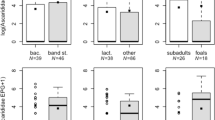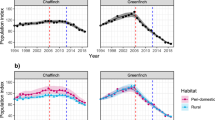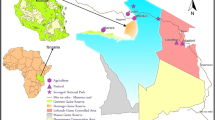Abstract
Supplementary feeding is widely used in game management but may aid the transmission of parasites. Firstly, feeding sites attract animals and may be regarded as high-risk areas for parasite transmission. Secondly, high host population densities resulting from and supported by supplementary feeding, as well as accumulation of parasites in the environment, may increase parasite prevalence. Our aim was to investigate whether host density or the number of feeding sites drives endoparasite infection in an Estonian wild boar (Sus scrofa) population. For this, we collected wild boar faeces from forests, and soil samples from supplementary feeding sites in central and south-eastern Estonia. The role of host density and number of feeding sites on both the risk and mean abundance of endoparasite infection was modelled using generalized linear models (GLM). The presence of biohelminths in faecal samples was associated with both wild boar and feeding site density, whereas the presence of Eimeria sp. oocysts in faecal samples was only associated with wild boar density. Helminth eggs were found more often from the soil of active and abandoned feeding sites than from control areas. This could reflect parasitic contamination or indicate that supplementary feeding sites are suitable habitat for soil-dwelling nematodes. These results suggest that the effects of supplementary feeding on parasite prevalence in wild boar are mediated by the characteristics of parasite life cycles.
Similar content being viewed by others
References
Acevedo P, Vicente J, Höfle U, Cassinello J, Ruiz-Fons F, Gortazar C (2007) Estimation of European wild boar relative abundance and aggrecation: a novel method in epidemiological risk assessment. Epidemiol Infect 135:519–527
Arneberg P (2001) An ecological law and its macroecological consequences as revealed by studies of relationships between host densities and parasite prevalence. Ecography 24:352–358
Arneberg P (2002) Host population density and body mass as determinants of species richness in parasite communities: comparative analyses of directly transmitted nematodes of mammals. Ecography 25:88–94
Bieber C, Ruf T (2005) Population dynamics in wild boar Sus scrofa: ecology, elasticity of growth rate and implications for the management of pulsed resource consumers. J Appl Ecol 42:1203–1213
Brmež M, Ivezić M, Raspudić E (2006) Effect of mechanical disturbances on nematode communities in arable land. Helminthologia 43:117–121. doi:10.2478/s11687-006-0022-0
Burnham KP, Anderson DR (2004) Multimodel inference understanding AIC and BIC in model selection. Sociol Methods Res 33:261–304. doi:10.1177/0049124104268644
Cellina S (2008) Effects of supplemental feeding on the body condition and reproductive state of wild boar (Sus scrofa) in Luxembourg. PhD thesis, University of Sussex, UK
Collender PA, Kirby AE, Addiss DG, Freeman MC, Remais JV (2015) Methods for quantification of soil-transmitted helminths in environmental media: current techniques and recent advances. Trends in Parasitol 31:625–639. doi:10.1016/j.pt.2015.08.007
Demeler J, Ramünke S, Wolken S, Ianiello D, Rinaldi L, Gahutu JB, Cringoli G, von Samson-Himmelstjerna G, Krücken J (2013) Discrimination of gastrointestinal nematode eggs from crude fecal egg preparations by inhibitor-resistant conventional and real-time PCR. PLoS One 8:e61285. doi:10.1371/journal.pone.0061285
Fernandez-de-Mera IG, Vicente J, Gortazar C, Höfle U, Fierro Y (2004) Efficacy of an in-feed preparation of ivermectin against helminths in the European wild boar. Parasitol Res 92:133–136
Foata J, Mouillot D, Culioli J-L, Marchand B (2006) Influence of season and host age on wild boar parasites in Corsica using indicator species analysis. J Helminthol 80:41–45
Gassó D, Feliu C, Ferrer D, Mentaberre G, Casas-Díaz E, Velarde R, Fernández-Aguilar X, Colom-Cadena A, Navarro-Gonzalez N, López-Olvera JR, Lavín S, Fenández-Llario P, Segalés J, Serrano E (2015) Uses and limitations of faecal egg count for assessing worm burden in wild boars. Vet Parasitol 209:133–137. doi:10.1016/j.vetpar.2015.02.006
Gompper ME, Wright AN (2005) Altered prevalence of raccoon roundworm (Baylisascaris procyonis) owing to manipulated contact rates of hosts. J Zool 266:215–219
Hines AM, Ezenwa VO, Cross P, Rogerson JD (2007) Effects of supplemental feeding on gastrointestinal parasite infection in elk (Cervus elaphus): preliminary observations. Vet Parasitol 148:350–355
Humbert J-F, Henry C (1989) Studies on the prevalence and the transmission of lung and stomach nematodes of the wild boar (Sus scrofa) in France. J Wildl Dis 25:335–341
Järvis T (1993) Uluksõraliste helmindid Eestis ja helmintooside tõrje [Helminths of wild artiodactyls in Estonia and helminthoses control]. D.Sc. Dissertation, Eesti Põllumajandusülikool, Tartu, Estonia (in Estonian, English summary)
Järvis T, Kapel C, Moks E, Talvik H, Mägi E (2007) Helminths of wild boar in the isolated population close to the northern border of its habitat area. Vet Parasitol 150:366–369
Jędrzejewski W, Jędrzejewska B, Okarma H, Ruprecht AL (1992) Wolf predation and snow cover as mortality factors in the ungulate community of the Bialowieża National Park, Poland. Oecologia 90:27–36
Jokelainen P, Velström K, Lassen B (2015) Seroprevalence of Toxoplasma gondii in free-ranging wild boars hunted for human consumption in Estonia. Acta Vet Scand 57:42
Kärssin A, Velström K, Gómez-Morales MA, Saar T, Jokelainen P, Lassen B (2016) Cross-sectional study of anti-Trichinella antibody prevalence in domestic pigs and hunted wild boars in Estonia. Vector Borne Zoonotic Dis 16:604–610. doi:10.1089/vbz.2016.1943
Larsen MN, Roepstorff A (1999) Seasonal variation in development and survival of Ascaris suum and Trichuris suis eggs on pastures. Parasitology 119:209–220
Lassen B, Lepik T (2014) Isolation of Eimeria oocysts from soil samples: a simple method described in detail. Agraarteadus 25:77–81
Levine ND (1985) Veterinary protozoology. The Iowa University State Press, Iowa, p 414
Martin C, Pastoret P-P, Brochier B, Humblet M-F, Saegerman C (2011) A survey of the transmission of infectious diseases/infections between wild and domestic ungulates in Europe. Vet Res 42:70. doi:10.1186/1297-9716-42-70
Massei G, Kindberg J, Licoppe A, Gačić D, Šprem N, Kamler J, Baubet E, Hohmann U, Monaco A, Ozoliņš J, Cellina S, Podgórski T, Fonseca C, Markov N, Pokorny B, Rosell C, Náhlik A (2015) Wild boar populations up, numbers of hunters down? A review of trends and implications for Europe. Pest Manag Sci 71:492–500. doi:10.1002/ps.3965
Milner JS, Wedul SJ, Laaksonen S, Oksanen A (2013) Gastrointestinal nematodes of moose (Alces alces) in relation to supplementary feeding. J Wildl Dis 49:69–79
Milner JS, van Beest FM, Schmidt KT, Brook RK, Storaas T (2014) To feed or not to feed? Evidence of the intended and unintended effects of feeding wild ungulates. J Wildl Manag 78:1322–1334
Nagy G, Csivincsik Á, Sugár L (2015) Wild boar density drives Metastrongylus infection in earthworm. Acta Parasitol 60:35–39
Navarro-Gonzalez N, Fernández-Llario P, Pérez-Martín JE, Mentaberre G, López-Martín JM, Lavín S, Serrano E (2013) Supplemental feeding drives endoparasite infection in wild boar in Western Spain. Vet Parasitol 196:114–123
Newcombe RG (1998) Two-sided confidence intervals for the single proportion: comparison of seven methods. Stat Med 17:857–872
Oja R, Kaasik A, Valdmann H (2014) Winter severity or supplementary feeding—which matters more for wild boar? Acta Theriol 59:553–559. doi:10.1007/s13364-014-0190-0
Oja R, Zilmer K, Valdmann H (2015) Spatiotemporal effects of supplementary feeding on wild boar (Sus scrofa) on artificial ground nest depredation. PLoS One 10:e0135254. doi:10.1371/journal.pone.0135254
Pilotte N, Papaiakovou M, Grant JR, Bierwert LA, Llewellyn S, McCarthy JS, Williams SA (2016) Improved PCR-based detection of soil transmitted helminth infections using a next-generation sequencing approach to assay design. PLoS Negl Trop Dis 10:e0004578. doi:10.1371/journal.pntd.0004578
Popiołek M, Knecht D, Szczęsna-Staśkiewicz J, Czerwińska-Rożałow A (2010) Helminths of the wild boar (Sus scrofa L.) in natural and breeding conditions. Bull Vet Inst Pulawy 53:161–166
Pyziel AM, Kowalczyk R, Demiaszkiewicz AW (2011) The annual cycle of shedding Eimeria oocysts by European bison (Bison bonasus) in the Bialowieza Primeval Forest, Poland. J Parasitol 97:737–739
R Development Core Team (2015) R: a language and environment for statistical computing. R Foundation for Statistical Computing, Vienna. Available: http://www.R-project.org. (version 3.2.2)
Risco D, Serrano E, Fernández-Llario P, Cuesta JM, Gonçalves P, García-Jiménez WL, Martínez R, Cerrato R, Velarde R, Gómez L, Segalés J, de Mendoza JH (2014) Severity of bovine tuberculosis is associated with co-infection with common pathogens in wild boar. PLoS One 9:e110123. doi:10.1371/journal.pone.0110123
Roberts MG, Dobson AP, Arneberg P, de Leo GA, Krecek RC, Manfredi MT, Lanfranchi P, Zaffaroni E (2003) Parasite community ecology and biodiversity. In: Hudson PJ, Rizzoli A, Grenfell BT, Heesterbeek H, Dobson AP (eds) The ecology of wildlife diseases. Oxford University Press, Oxford, pp 63–82
Roepstorff A, Nansen P (1998) Epidemiology, diagnosis and control of helminth parasites of swine. FAO Animal Health Manual, Rome
Rosvold J, Andersen R (2008) Wild boar in Norway—is climate a limiting factor? Norges teknisk-naturvitenskapelige universitet Vitenskapsmuseet. Rapp Zool Ser 1:1–23
Servanty S, Gaillard J-M, Toïgo C, Brandt S, Baubet E (2009) Pulsed resources and climate-induced variation in the reproductive traits of wild boar under high hunting pressure. J Anim Ecol 78:1278–1290
Sorensen A, van Beest FM, Brook RK (2014) Impacts of wildlife baiting and supplemental feeding on infectious disease transmission risk—a synthesis of knowledge. Prev Vet Med 113:356–363
Venables WN, Ripley BD (2002) Modern applied statistics with S, Fourth edn. Springer, New York
Vicente J, Höfle U, Fernández-De-Mera IG, Gortazar C (2007) The importance of parasite life history and host density in predicting the impact of infections in red deer. Oecologia 152:655–664
WHO (2004) Integrated guide to sanitary parasitology. Regional Office for the Eastern Mediterranean. P.O. Box 7608, Nasr City, Cairo 1 1371. Egypt/Regional Centre for Environmental Health Activities, Amman
Zeithaml J, Pižl V, Sklenička P (2009) Earthworm assemblages in an ecotone between forest and arable field and their relations with soil properties. Pesq Agrop Brasileira 44:922–926. doi:10.1590/S0100-204X2009000800018
Zhao J, Neher DA (2013) Soil nematode genera that predict specific types of disturbance. Appl Soil Ecol 64:135–141. doi:10.1016/j.apsoil.2012.11.008
Acknowledgements
This work was supported by the State Forest Management Centre and the Estonian Research Council (grant IUT-2032). We are grateful to John Davison for proof-reading the manuscript and providing useful comments.
Author information
Authors and Affiliations
Corresponding author
Electronic supplementary material
Online Resource 1
(DOCX 404 kb)
Online Resource 2
(DOCX 13 kb)
Online Resource 3
(DOCX 13 kb)
Online Resource 4
(DOCX 13 kb)
Online Resource 5
(DOCX 14 kb)
Rights and permissions
About this article
Cite this article
Oja, R., Velström, K., Moks, E. et al. How does supplementary feeding affect endoparasite infection in wild boar?. Parasitol Res 116, 2131–2137 (2017). https://doi.org/10.1007/s00436-017-5512-0
Received:
Accepted:
Published:
Issue Date:
DOI: https://doi.org/10.1007/s00436-017-5512-0




